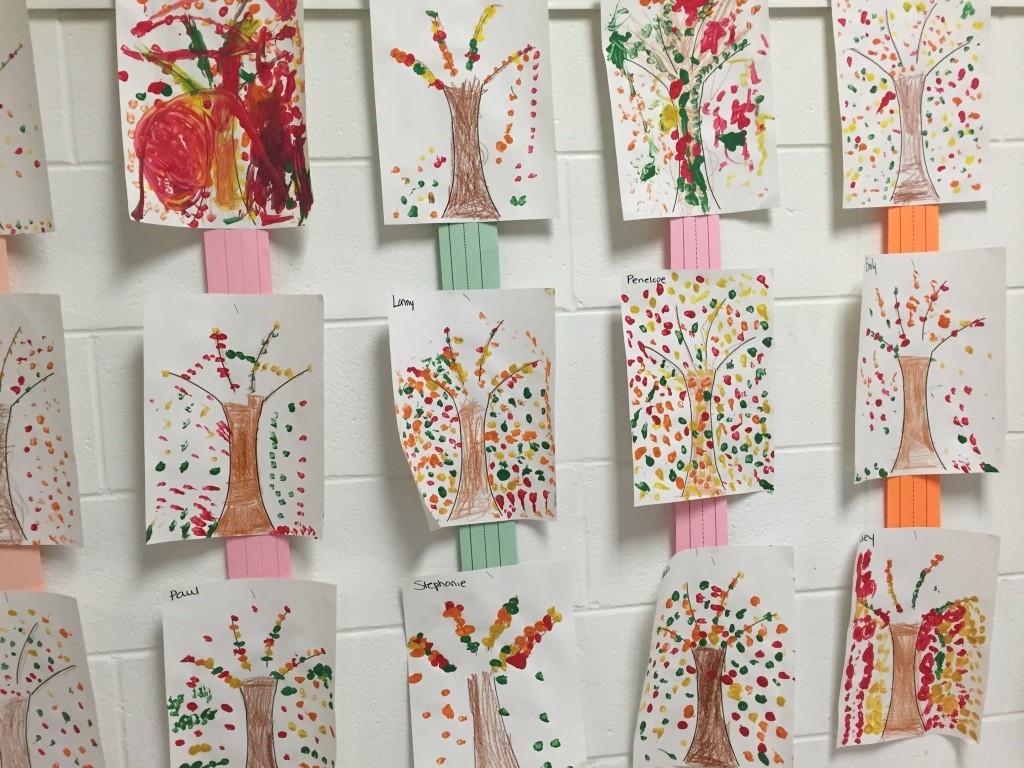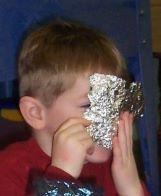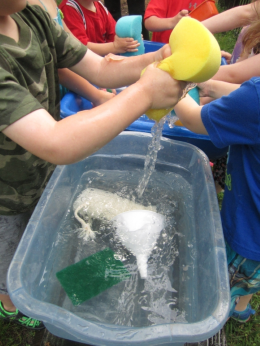The Early Years
How Crafts Can Be a Science Learning Experience
By Peggy Ashbrook
Posted on 2020-12-07

Disclaimer: The views expressed in this blog post are those of the author(s) and do not necessarily reflect the official position of the National Science Teaching Association (NSTA).
Making a copy of an adult-made craft may satisfy children’s interest in handling materials, cutting, gluing, and painting. This spring I followed several online instructions and video examples to make face masks, happy to have a model to copy so I did not have to invent a pattern or process. Yet I found the finished product needed some small changes to fit me and my various–sized family members well and comfortably. Children may make small changes to their version of a craft, too: gluing on more leaves than are on the model, or making thumbprint “leaves” in unlikely places and even finger painting all over the page. (See photo above. Credit: Peggy Ashbrook)
Making crafts can support imaginative play, helping children create props for their roles: A foil-covered stick as a sword may seem “more real” than the stick alone. Add a paper cape marked with a star, and a superhero is fully outfitted, one who may already be thinking of how to use the rest of the roll of foil!
The Bay Area Discovery Museum urges educators to “build children’s creative problem-solving skills through intentional experiences” and offers their CREATE pedagogical framework. They note that “choice boosts intrinsic motivation in children, which in turn boosts creativity,” and personal connections to an investigation supports their persistence with a project. C hoosing how to use the foil and making it work the way they desire means children are discovering properties such as how it bends and folds, if it can be straightened out again, and will it hold tape if it gets torn.
hoosing how to use the foil and making it work the way they desire means children are discovering properties such as how it bends and folds, if it can be straightened out again, and will it hold tape if it gets torn.
(photo by Peggy Ashbrook)
Science learning about natural phenomena happens during craft-making. The natural phenomena preschool children experience as they make crafts may include the thickness and stickiness of paint (viscosity) and how it adheres to different surfaces such as paper, clothing, or floor tiles. The movement of water absorbed into a cloth, evaporation of liquids, hardening of glue, the action of scissors on various materials, and brittleness of wax crayons are all phenomena that are experienced by many preschoolers but taken for granted by most educators. Children will experience the same science phenomena if they simply handle and use the materials without a model craft creation to imitate. Involve children in open-ended exploration over multiple days to help them “engage deeply with the material in order to generate an explanation of the phenomenon....” (Achieve, Inc. 2016)
“The three most important aspects of a teacher’s role in primary science…[are] providing (interesting) materials for children to observe and investigate, asking the right kinds of questions, and helping children to discuss, or more widely, to communicate their thinking and developing ideas." (Harlen 2003) This view of the teachers’ role is echoed in NSTA’s Position Statement on Early Childhood Science Education. (NSTA 2014) One of the key principles is “Adults play a central and important role in helping young children learn science.”
Phenomena that act at an atomic level are experienced by young children even though they cannot “see” what is happening. They have ideas about how processes—such as evaporation—work, as noted in A Framework for K–12 Science Education: “Thus before they even enter school [kindergarten], children have developed their own ideas about the physical, biological, and social worlds and how they work. By listening to and taking these ideas seriously, educators can build on what children already know and can do. Such initial ideas may be more or less cohesive and sometimes may be incorrect. However, some of children’s early intuitions about the world can be used as a foundation to build remarkable understanding, even in the earliest grades. Indeed, both building on and refining prior conceptions (which can include misconceptions) are important in teaching science at any grade level.” (NRC 2012, pp. 24–25)
Providing multiple experiences with phenomena that are “compelling to students based on their experiences in their homes and communities” (Lee 2020, p. 56) helps children begin to make sense of phenomena. For example, children are familiar with wet clothing from spills and wet weather play. We can ask them, “I wonder…where did the water go?” to hear their ideas. We can use prompts to encourage them to reflect on their ideas: “Okay, how do you know that? What makes you think that?” And later, “What evidence do you have for that idea?”

What is compelling to your students may be different from what engages other classes, but consider such phenomena as water soaking into sand or sponges, lifting a kite by pulling it on a string, falling snow accumulation, rolling balls down slopes, and observing plant and animal growth. Open-ended play with sand, kites, snow, rolling balls, and growing plants may raise questions that children verbalize or express by their repeated actions: Does water always soak into sand, how fast does it “disappear,” or how much water can a certain size sponge hold? Do some kite shapes fly better than others? Does the force of the wind help or hinder kite flying? How can we measure how much snow fell? Do balls roll faster down a steep slope?
By providing time for children to document their observations, think about them, and discuss what they observe, educators can build on what children already understand. This means allowing time for exploring and talking about phenomena during craft-making, repeating experiences to further explore the phenomenon that interests the children, and letting go of a finished concrete product as a symbol of successful learning.
References
Achieve, Inc. 2016. Using phenomena in NGSS-designed lessons and units. www.nextgenscience.org/sites/default/files/Using%20Phenomena%20in%20NGSS.pdf.
Bay Area Discovery Museum. 2017. The CREATE Framework: Learning Environments to Develop Creativity. Sausalito, CA.
https://37726n2dobnw25rhl01gna4e-wpengine.netdna-ssl.com/wp-content/uploads/2020/06/Create_Framework_OUTLINED_Lo-Rez.pdf.
Harlen, W. 2003. Primary science: Taking the plunge. Portsmouth, NH: Heinemann.
Lee, O. 2020. Making everyday phenomena phenomenal: Using phenomena to promote equity in science instruction. Science and Children 58 (1): 56–61.
National Research Council (NRC). 2012. A framework for K–12 science education: Practices, crosscutting concepts, and core ideas. Washington, DC: National Academies Press.
National Science Teaching Association (NSTA). 2014. Early childhood science education. NSTA position statement. www.nsta.org/nstas-official-positions/early-childhood-science-education.
NGSS Phenomena Teaching Strategies Early Childhood


